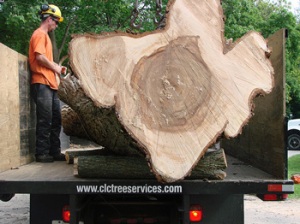Sure was.
“How old was it?”
You have to count the rings to find out.
“How do I find out, if the tree is still alive and I don’t want to cut it down?”
If the tree is still growing, you can use an increment borer to take a core sample. An increment borer takes a cylindrical cross-section of the tree without damaging it. They can be as small as 4.35 mm or as large as 12mm, but the usual size is 5.15mm or 0.200″. That way you can know the tree’s age and any other pertinent information you might want, but still get the benefit of your living tree.
“Neat! I bet this old tree went through a lot in its lifetime.”
Actually, you can tell a lot about the tree’s life, and the climate that the tree was exposed to by its rings. Every year a tree gets a little wider. That’s due to a new layer of wood being produced in the cambium; the layer between the bark and old wood of the tree. Each ring has a distinctive mark from the spring when it is wetter, to the drier summer months. The tree’s cells are larger and grow more rapidly in the spring, due to climates more suited to growth. During the summer, or in drought conditions, the rings spread out further, as the cells are smaller and the wood produced is more dense. In the winter, trees go dormant, so there are no new cells produced. That means that by the next spring when a new layer of wood grows in the cambium, you can tell where the new ring begins; a year in the life of a tree.
“I didn’t know that.”
Incidentally, the study of tree rings is called dendrochronology and was first developed by Andrew E. Douglass. He was an American astronomer that noted an association between sunspots and tree rings at the beginning of the 20th Century. With the help of an archaeologist by the name of Wissler, they developed the science of studying tree rings and climactic changes. It’s pretty interesting stuff and can also be used to date old wooden buildings and furniture.
“Hunh. So what was the story behind this old tree?”
The story is in the rings my friend. Count the rings.




You must be logged in to post a comment.